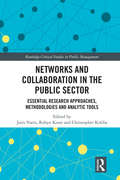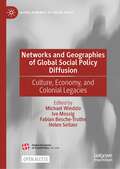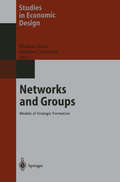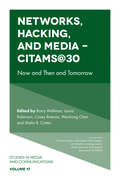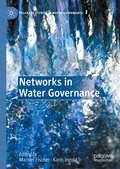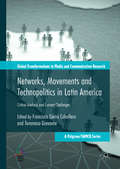- Table View
- List View
Networking the Farm: The Social Structure of Cooperation and Competition in Iowa Agriculture (Routledge Revivals)
by Randy ZiegenhornPublished in 1999, this book presents the results of an ethnographic study of the emergence of co-operative production networks among hog farm workers in Iowa. In it the author assesses both the internal organizational requirements for the successful network formation and the potential for networks to give farmers a competitive edge in the swine industry. Departing from the traditional emphasis on individual decision making in agricultural economies and economic anthropology, this book emphasizes instead the institutional setting in which such networks are formed. The author argues that networks succeed when they are closely tied to and reflective of local social structure. Those networks that attempt to employ a master plan designed by experts often fail. Although many succesful networks exist, networking has yet to achieve the economic clout enjoyed by large scale corporate swine producers. The author describes the availability of credit for new swine production ventures in Iowa and shows the extent to which large scale producers have developed network-like connections with banks, packers, and contract producers.
Networking the Farm: The Social Structure of Cooperation and Competition in Iowa Agriculture (Routledge Revivals)
by Randy ZiegenhornPublished in 1999, this book presents the results of an ethnographic study of the emergence of co-operative production networks among hog farm workers in Iowa. In it the author assesses both the internal organizational requirements for the successful network formation and the potential for networks to give farmers a competitive edge in the swine industry. Departing from the traditional emphasis on individual decision making in agricultural economies and economic anthropology, this book emphasizes instead the institutional setting in which such networks are formed. The author argues that networks succeed when they are closely tied to and reflective of local social structure. Those networks that attempt to employ a master plan designed by experts often fail. Although many succesful networks exist, networking has yet to achieve the economic clout enjoyed by large scale corporate swine producers. The author describes the availability of credit for new swine production ventures in Iowa and shows the extent to which large scale producers have developed network-like connections with banks, packers, and contract producers.
Networks and Collaboration in the Public Sector: Essential research approaches, methodologies and analytic tools (Routledge Critical Studies in Public Management)
by Joris Voets Robyn Keast Christopher KolibaNetworks and other collaborations are central to the public sector’s ability to respond to their diverse responsibilities, from international development and regional governance, to policy development and service provision. Great strides have been made toward understanding their formation, governance and management, but more opportunities to explore methodologies and measures is required to ensure they are properly understood. This volume showcases an array of selected research methods and analytics tools currently used by scholars and practitioners in network and collaboration research, as well as emerging styles of empirical investigation. Although it cannot attempt to capture all technical details for each one, this book provides a unique catalogue of compelling methods for researchers and practitioners, which are illustrated extensively with applications in the public and non-profit sector. By bringing together leading and upcoming scholars in network research, the book will be of enormous assistance in guiding students and scholars in public management to study collaboration and networks empirically by demonstrating the core research approaches and tools for investigating and evaluating these crucially important arrangements.
Networks and Geographies of Global Social Policy Diffusion: Culture, Economy, and Colonial Legacies (Global Dynamics of Social Policy)
by Michael Windzio Ivo Mossig Fabian Besche-Truthe Helen SeitzerThis open access book analyses the global diffusion of social policy as a process driven by multiplex ties between countries in global social networks. The contributions analyze links between countries via global trade, colonial history, similarity in culture, and spatial proximity. Networks are viewed as the structural backbone of the diffusion process, and diffusion is anlaysed via several subfields of social policy, in order to interrogate which network dimensions drive this process. The focus is on a global perspective of social policy diffusion via networks, and it is the first book to explicitly follow this macro-quantitative perspective on diffusion at a global scale whilst also comparing different networks. The collection tests the network structures in terms of their relevance to the diffusion process in different subfields of social policy such as old age and survivor pensions, labor and labor markets, health and long-term care, education and training, and family and gender policy.The book will therefore be invaluable to students and researchers of global social policy, sociology, political science, international relations, organization theory and economics.
Networks and Groups: Models of Strategic Formation (Studies in Economic Design)
by Bhaskar Dutta Matthew O. JacksonWhen Murat Sertel asked us whether we would be interested in organizing a special issue of the Review of Economic Design on the formation of networks and groups, we were happy to accept because of the growing research on this important topic. We were also pleasantly surprised at the response to our request for submissions to the special issue, receiving a much larger number of sub missions than we had anticipated. In the end we were able to put together two special issues of insightful papers on this topic. Given the growing interest in this topic, we also decided (with encouragement from Murat) to combine the special issues in the form of a book for wider dissemination. However, once we had decided to edit the book, it was natural to move beyond the special issue to include at least some of the papers that have been influential in the literature on the formation of networks. These papers were published in other journals, and we are very grateful to the authors as well as the journals for permission to include these papers in the book.
Networks and Marginality: Life in a Mexican Shantytown
by Larissa Adler LomnitzNetworks and Marginality: Life in a Mexican Shantytown describes the life and survival of economically marginal or poor people in Cerrada del Cóndor, a shantytown of about 200 houses in the southern part of Mexico City. The field work is carried out between 1969 and 1971 using combined anthropological and quantitative methods. This book is composed of 10 chapters and begins with an overview of the theoretical concepts essential for an adequate comprehension of the later chapters, followed by a summary of the development and evolution of Mexico City as they relate to Cerrada del Cóndor. Considerable chapters examine the migration process, the economy, the family and kinship patterns, and the reciprocity networks and associated mechanisms of survival value in the shantytown. The remaining chapters discuss some of the relevant theoretical points raised by the findings, including the reciprocity, the confianza concept, and the importance of informal economic exchange in complex urban societies.This book will prove useful to economists, anthropologists, social scientists, and researchers.
Networks and Network Analysis for Defence and Security (Lecture Notes in Social Networks)
by Anthony J. MasysNetworks and Network Analysis for Defence and Security discusses relevant theoretical frameworks and applications of network analysis in support of the defence and security domains. This book details real world applications of network analysis to support defence and security. Shocks to regional, national and global systems stemming from natural hazards, acts of armed violence, terrorism and serious and organized crime have significant defence and security implications. Today, nations face an uncertain and complex security landscape in which threats impact/target the physical, social, economic and cyber domains. Threats to national security, such as that against critical infrastructures not only stem from man-made acts but also from natural hazards. Katrina (2005), Fukushima (2011) and Hurricane Sandy (2012) are examples highlighting the vulnerability of critical infrastructures to natural hazards and the crippling effect they have on the social and economic well-being of a community and a nation. With this dynamic and complex threat landscape, network analysis has emerged as a key enabler in supporting defence and security. With the advent of ‘big data’ and increasing processing power, network analysis can reveal insights with regards to structural and dynamic properties thereby facilitating greater understanding of complex networks, their entities, interdependencies, vulnerabilities to produce insights for creative solutions. This book will be well positioned to inform defence, security and intelligence professionals and researchers with regards to leading methodologies and approaches.
Networks and the Spread of Ideas in the Past: Strong Ties, Innovation and Knowledge Exchange (Digital Research in the Arts and Humanities)
by Anna CollarNetworks and the Spread of Ideas in the Past: Strong Ties, Innovation and Knowledge Exchange gathers contributions from an international group of scholars to reconsider the role that strong social ties play in the transmission of new ideas, and their crucial place in network analyses of the past. Drawing on case studies that range from the early Iron Age Mediterranean to medieval Britain, the contributing authors showcase the importance of looking at strong social ties in the transmission of complex information, which requires relationships structured through mutual trust, memory, and reciprocity. They highlight the importance of sanctuaries in the process of information transmission; the power of narrative in creating a sense of community even across geographical space; and the control of social systems in order to facilitate or stifle new information transfer. Networks and the Spread of Ideas in the Past demonstrates the value of searching the past for powerful social connections, offers us the chance to tell more human stories through our analyses, and represents an essential new addition to the study and use of networks in archaeology and history. The book will be useful to academics and students working in the Digital Humanities, History, Archaeology.
Networks and the Spread of Ideas in the Past: Strong Ties, Innovation and Knowledge Exchange (Digital Research in the Arts and Humanities)
by Anna CollarNetworks and the Spread of Ideas in the Past: Strong Ties, Innovation and Knowledge Exchange gathers contributions from an international group of scholars to reconsider the role that strong social ties play in the transmission of new ideas, and their crucial place in network analyses of the past. Drawing on case studies that range from the early Iron Age Mediterranean to medieval Britain, the contributing authors showcase the importance of looking at strong social ties in the transmission of complex information, which requires relationships structured through mutual trust, memory, and reciprocity. They highlight the importance of sanctuaries in the process of information transmission; the power of narrative in creating a sense of community even across geographical space; and the control of social systems in order to facilitate or stifle new information transfer. Networks and the Spread of Ideas in the Past demonstrates the value of searching the past for powerful social connections, offers us the chance to tell more human stories through our analyses, and represents an essential new addition to the study and use of networks in archaeology and history. The book will be useful to academics and students working in the Digital Humanities, History, Archaeology.
Networks for Water Policy: A Comparative Perspective (Routledge Library Editions: Water Resources)
by Hans Bressers Laurence J. O’Toole Jr Jeremy RichardsonNetwork models for analysing public policy have become widely used in recent years. This volume, originally published in 1995, assesses the network idea by applying a common perspective on network analysis to the constellations involved in water policy formation and implementation in England and Wales, Germany, Hungary, the Netherlands, the USA and at the level of the EU. Water policy – addressing basic human needs for the supply of adequate surface and groundwater as well as for the maintenance and improvement of water quality, is an increasingly salient subject. Each case covered in this volume treats the issues of water policy network composition and structure, and determinants of network characteristics, as well as documenting the influence of the networks on policy developments towards more network openness, emulation of business behaviour nd less domination by traditional professional groups such as engineers. Essays by the editors provide a common analytical perspective and offer both explicitly-comparative conclusions and evidence-based assessments of the strengths and limitations of the network perspective.
Networks for Water Policy: A Comparative Perspective (Routledge Library Editions: Water Resources)
Network models for analysing public policy have become widely used in recent years. This volume, originally published in 1995, assesses the network idea by applying a common perspective on network analysis to the constellations involved in water policy formation and implementation in England and Wales, Germany, Hungary, the Netherlands, the USA and at the level of the EU. Water policy – addressing basic human needs for the supply of adequate surface and groundwater as well as for the maintenance and improvement of water quality, is an increasingly salient subject. Each case covered in this volume treats the issues of water policy network composition and structure, and determinants of network characteristics, as well as documenting the influence of the networks on policy developments towards more network openness, emulation of business behaviour nd less domination by traditional professional groups such as engineers. Essays by the editors provide a common analytical perspective and offer both explicitly-comparative conclusions and evidence-based assessments of the strengths and limitations of the network perspective.
Networks, Hacking and Media - CITAMS@30: Now and Then and Tomorrow (Studies in Media and Communications #17)
by Barry Wellman Laura Robinson Casey Brienza Wenhong Chen Shelia CottenSponsored by the Communication, Information Technologies, and Media Sociology section of the American Sociological Association (CITAMS), this volume celebrates the section's thirtieth anniversary. Lead editor Barry Wellman joins forces with former and current CITAMS chairs Wenhong Chen, Shelia Cotten, and Laura Robinson, as well as Casey Brienza, founder of the Media Sociology Preconference, to look back at the history of the section, review some of its most important themes, and set the agenda for future discussion. Alongside its sister volume, The "M" in CITAMS@30: Media Sociology, this valuable book shows the impact CITAMS has had, and continues to have, on academic and public discourse. Featuring leading scholars in the fields of sociology of communication, information technologies and media, it reveals how the section had transcended disciplinary boundaries, and demonstrates how it holds the skills to address some of the biggest challenges of our digital age. It is essential reading for all those interested in both the story of CITAMS to date, and the role it will play in the future.
Networks, Hacking and Media - CITAMS@30: Now and Then and Tomorrow (Studies in Media and Communications #17)
by Barry Wellman Laura Robinson Casey Brienza Wenhong Chen Shelia R. CottenSponsored by the Communication, Information Technologies, and Media Sociology section of the American Sociological Association (CITAMS), this volume celebrates the section's thirtieth anniversary. Lead editor Barry Wellman joins forces with former and current CITAMS chairs Wenhong Chen, Shelia Cotten, and Laura Robinson, as well as Casey Brienza, founder of the Media Sociology Preconference, to look back at the history of the section, review some of its most important themes, and set the agenda for future discussion. Alongside its sister volume, The "M" in CITAMS@30: Media Sociology, this valuable book shows the impact CITAMS has had, and continues to have, on academic and public discourse. Featuring leading scholars in the fields of sociology of communication, information technologies and media, it reveals how the section had transcended disciplinary boundaries, and demonstrates how it holds the skills to address some of the biggest challenges of our digital age. It is essential reading for all those interested in both the story of CITAMS to date, and the role it will play in the future.
Networks In The Global Village: Life In Contemporary Communities (PDF)
by Barry WellmanNetworks in the Global Village examines how people live through personal communities: their networks of friends, neighbors, relatives, and coworkers. It is the first book to compare the communities of people around the world. Major social differences between and within the First, Second, and Third Worlds affect the opportunities and insecurities with which individuals and households must deal, the supportive resources they seek, and the ways in which markets, institutions, and networks structure access to these resources. Each article written by a resident shows how living in a country affects the ways in which people use networks to access resources. Most people's ties in the developed world are not with neighbours, but are widely dispersed. Unlike traditional studies of communities, social network analysis can identify the flourishing personal communities that people do have, no matter how far their ties may stretch and how fragmented their communities may be. Social networks are one of the principal means by which people and households acquire resources. Either directly, through informal exchanges, or indirectly, by providing information on how to access the services provided by governments and other institutions. Networks in the Global Village focuses on how people use these networks around the world.
Networks In The Global Village: Life In Contemporary Communities
by Barry WellmanNetworks in the Global Village examines how people live through personal communities: their networks of friends, neighbors, relatives, and coworkers. It is the first book to compare the communities of people around the world. Major social differences between and within the First, Second, and Third Worlds affect the opportunities and insecurities w
Networks in Water Governance (Palgrave Studies in Water Governance: Policy and Practice)
by Manuel Fischer Karin IngoldWith the consequences of climate change and biodiversity loss becoming more and more apparent, both the protection of water resources and water-related ecosystems as well as protection from water, that is flood protection policies, have become increasingly important. This book explores the latest applications of network analysis concepts and measures to the study and practice of water governance. Given the holistic complexity of water governance, it covers individual water governance aspects such as flood protection and fisheries, as well as overarching concepts like integrated water management and social-ecological interactions. The book provides an overview of current water governance issues, network analytic concepts as well as implications for practice. The main body of the text is made up of eight case studies by world-leading environmental governance scholars, each of which addresses one water-related challenge by applying a variety of network approaches. The first part of the book highlights network dispersion and fragmentation, the second focuses on how such fragmentation in networks can be overcome and the third deals with specific roles of actors in networks. This collection is a key resource for scholars and practitioners interested in water governance all over the world. It provides readers with an overview of the potential of network analytic concepts for research on complex governance problems.
Networks, Knowledge Brokers, and the Public Policymaking Process
by Matthew S. Weber Itzhak YanovitzkySocial network analysis provides a meaningful lens for advancing a more nuanced understanding of the communication networks and practices that bring together policy advocates and practitioners in their day-to-day efforts to broker evidence into policymaking processes. This book advances knowledge brokerage scholarship and methodology as applied to policymaking contexts, focusing on the ways in which knowledge and research are utilized, and go on to influence policy and practice decisions across domains, including communication, health and education. There is a growing recognition that knowledge brokers – key intermediaries – have an important role in calling attention to research evidence that can facilitate the successful implementation of evidence-informed policies and practices. The chapters in this volume focus explicitly on the history of knowledge brokerage research in these contexts and the frameworks and methodologies that bridge these disparate domains. The contributors to this volume offer useful typologies of knowledge brokerage and explicate the range of causal mechanisms that enable knowledge brokers’ influence on policymaking. The work included in this volume responds to this emerging interest by comparing, assessing, and delineating social network approaches to knowledge brokerage across domains. The book is a useful resource for students and scholars of social network analysis and policymaking, including in health, communication, public policy and education policy.
Networks, Movements and Technopolitics in Latin America: Critical Analysis and Current Challenges (PDF)
by Francisco Sierra Caballero Tommaso GravanteThis edited collection presents original and compelling research about contemporary experiences of Latin American movements and politics in several countries. The book proposes a theoretical framework that conceptualises different mediation processes that emerge between cyberdemocracy and the emancipation practices of new social movements. Additionally, this volume presents some Latin American practices and experiences that are autonomously and by using self-management–creating other identities and social spaces on the margins of and against the neoliberal system through the use of digital technology. This book will be of great interest to scholars of media and social movements studies as well as of contemporary politics.
Networks of Collective Action: A Perspective on Community Influence Systems
by Edward O. Laumann Franz U. PappiNetworks of Collective Action: A Perspective on Community Influence Systems develops a theoretically informed research framework for the structural analysis of social systems. To this end, special attention is given to two fundamental issues in structural analysis: First, how does one most usefully define or identify the elementary units, be they individuals, corporate actors, or population subgroups, that comprise a given social system, and in what ways should these elementary units be characterized or differentiated from one another? And, second, what are the relational modalities by which these actors are linked to one another in ways that are relevant to understanding how their individual preferences and behavior are coordinated or integrated with one another for purposes of collective action (i.e., to achieve collective goals)? The book is organized into three main parts. Part I describes the research site and its environmental context, and then makes a structural analysis of the internal social and value differentiation of the population subsystem. Part II focuses on the elite subsystem and on its role in resolving specific community controversies. Part III turns to a topic often neglected in studying democratically legitimized influence systems: the systematic theoretical and empirical characterization of the relationships between the elite and the population subsystems in the community.
Networks of Echoes: Imitation, Innovation and Invisible Leaders (Computational Social Sciences)
by Bruce J. West Malgorzata Turalska Paolo GrigoliniNetworks of Echoes: Imitation, Innovation and Invisible Leaders is a mathematically rigorous and data rich book on a fascinating area of the science and engineering of social webs. There are hundreds of complex network phenomena whose statistical properties are described by inverse power laws. The phenomena of interest are not arcane events that we encounter only fleetingly, but are events that dominate our lives. We examine how this intermittent statistical behavior intertwines itself with what appears to be the organized activity of social groups. The book is structured as answers to a sequence of questions such as: How are decisions reached in elections and boardrooms? How is the stability of a society undermined by zealots and committed minorities and how is that stability re-established? Can we learn to answer such questions about human behavior by studying the way flocks of birds retain their formation when eluding a predator? These questions and others are answered using a generic model of a complex dynamic network—one whose global behavior is determined by a symmetric interaction among individuals based on social imitation. The complexity of the network is manifest in time series resulting from self-organized critical dynamics that have divergent first and second moments, are non-stationary, non-ergodic and non-Poisson. How phase transitions in the network dynamics influence such activity as decision making is a fascinating story and provides a context for introducing many of the mathematical ideas necessary for understanding complex networks in general. The decision making model (DMM) is selected to emphasize that there are features of complex webs that supersede specific mechanisms and need to be understood from a general perspective. This insightful overview of recent tools and their uses may serve as an introduction and curriculum guide in related courses.
Networks of Power: Political Relations in the Late Postclassic Naco Valley (Mesoamerican Worlds : From The Olmecs To The Danzantes Ser.)
by Edward Schortman Patricia Urban Patricia A UrbanLittle is known about how Late Postclassic populations in southeast Mesoamerica organized their political relations. Networks of Power fills gaps in the knowledge of this little-studied area, reconstructing the course of political history in the Naco Valley from the fourteenth through early sixteenth centuries. Describing the material and behavioral patterns pertaining to the Late Postclassic period using components of three settlements in the Naco Valley of northwestern Honduras, the book focuses on how contests for power shaped political structures. Power-seeking individuals, including but not restricted to ruling elites, depended on networks of allies to support their political objectives. Ongoing and partially successful competitions waged within networks led to the incorporation of exotic ideas and imported items into the daily practices of all Naco Valley occupants. The result was a fragile hierarchical structure forever vulnerable to the initiatives of agents operating on local and distant stages. Networks of Power describes who was involved in these competitions and in which networks they participated; what resources were mustered within these webs; which projects were fueled by these assets; and how, and to what extent, they contributed to the achievement of political aims.
Networks of Power in Palestine: Family, Society and Politics Since the Nineteenth Century
by Harel Chorev-HalewaInformal networks are an elusive and hidden factor in every society. In the Middle East, the Arab Spring recently highlighted their power and scope from Iraq to Morocco, exposing how family and clan networks wield influence behind institutional facades. While many studies of Middle Eastern societies solely analyse formal structures and official governing bodies, this book illuminates longstanding informal social systems by examining the sociopolitical history of the Palestinian highlands, known from 1950 as the West Bank. By studying family-based networks in cities like Jerusalem, Nablus and Hebron, Harel Chorev-Halewa shows how their influence has receded more slowly and less dramatically in recent generations than is commonly believed. He also connects individual elite families to the broader landscape of informal networks, comprising inter-familial alliances, collective economic systems, Sufi orders and customary law - all of which make up the unseen 'familial order.' Unfolding chronologically, this book spans a period of immense change from the Late Ottoman period to the present day, asking: How did Palestinian informal networks adapt to new realities?Why and how did they endure?And what does this say about modern Palestinian national politics in particular, and Arab societies in general? Offering an original and innovative look at informal networks in Palestine, this study is of crucial importance to scholars of Middle East studies, Palestine studies, political science and anthropology.
Networks, SMEs, and the University: The Process of Collaboration and Open Innovation
by Andrew Johnston Robert HugginsExploring the process of university collaboration from the perspective of small- and medium-sized enterprises (SMEs), this book offers an in-depth examination of the collaboration process, dispelling the myth of the disengagement of these firms. Andrew Johnston and Robert Huggins present a thorough account of how SMEs can ‘unlock the ivory tower’ and gain access to university knowledge to support their own innovation. Outlining and discussing the intellectual roots of research in this field in an accessible way, the book focuses on SMEs to provide insight to an often overlooked group of firms. Chapters show how the closeness of the partners in terms of network membership, working culture and practice, and technical language drive the formation and function of these collaborative links, offering a holistic account of this from idea generation to the completion of projects. This will be an essential read for academics researching innovation and the role of universities, as well as knowledge exchange practitioners wishing to further their understanding of collaboration processes. Policymakers seeking to explore how and why SMEs engage in open innovation practices will also find this an invigorating book.
Netzwerk Europa: Wie ein Kontinent durch Mobilität und Kommunikation zusammenwächst (Neue Bibliothek der Sozialwissenschaften)
by Jan Delhey Emanuel Deutschmann Monika Verbalyte Auke AplowskiDas Buch zeigt auf, wie sehr Europa in den letzten Jahrzehnten auf dem Weg zu einer immer engeren Union der Bürgerinnen und Bürger vorangekommen ist. Fast unbemerkt von Öffentlichkeit und Wissenschaft hat sich Europa „von unten“, durch grenzüberschreitende Aktivitäten der Menschen, sozial integriert. Mit anderen Worten: Es gibt unzählige Prozesse der europäischen Vergesellschaftung, die sich zum Netzwerk Europa verdichtet haben – keine supranationale Gesellschaft im klassischen Sinne, sondern ein Verdichtungsraum personeller Mobilität und Kommunikation. Das Buch widmet sich dieser europäischen Vergesellschaftung anhand von Migration, Auslandsstudium, Tourismus und Telefonie – und diskutiert, welche Chancen und Konflikte sich daraus für das Zusammenleben der Europäerinnen und Europäer ergeben.
Netzwerk- und Sozialraumarbeit im Kontext von Migration, Flucht und Integration
by Süleyman GögercinDas Buch zeigt, wo Theorie und Praxis einer netzwerk- und sozialraumorientierten Sozialen Arbeit im Kontext von Migration, Flucht und Integration stehen und wie und wohin sie miteinander verzahnt weiterentwickelt werden könnten. Anliegen des Buches ist es, die in Theorie und Praxis gemachten Erfahrungen und gesammelten Erkenntnisse zu bündeln, das aktuell verfügbare Konzept- und Handlungswissen für Netzwerk- und Sozialraumarbeit zu erschließen und zu erweitern, den erreichten Diskussionsstand aufzuzeigen sowie Anstöße für weiterführende Diskussionen und Weiterentwicklung der Sozialen Arbeit zu liefern.

